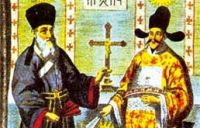Xu Guangqi
Xu Guangqi (Chinese: 徐光启), born in Shanghai in 1562, was an outstanding scientist in the Ming Dynasty.
Although Xu achieved the rank of "Jinshi" ("Presented Scholar") in the imperial exam, he was forced to retire from public office due to the corruption in the Ming government. After returning to his home in Shanghai, he focused on his scientific research.
In 1600, Xu came across Matteo Ricci of Italy. Under Ricci's tutelage, Xu learned about science and translated the first six volumes of the "Principles of Geometry," followed by the "Principles of Surveying" and the "Principles of Pythagorean Trigonometry."
Xu was a paramount figure in the fields of science and culture in China. He recommended advanced military defense techniques and advocated weather tracking as a means to improve the country's agriculture and trade. He was also the author of the "Nongzheng Quanshu" (Complete Treatise on Agriculture), one of four greatest agricultural books of China.
Though Xu lived in troubled times, he was still a devoted patriot in aiding the rural farmers of China, with his main interests lying in irrigation, fertilizers, famine relief, economic crops. He also kept empirical records of his observations, even including within it early notions of chemistry. It was an enormous written work, with some 700,000 written Chinese characters.
He also made great achievements in mathematics, biology and astronomy.
Xu passed away in Beijing on December 8, 1633 at the age of 71.
